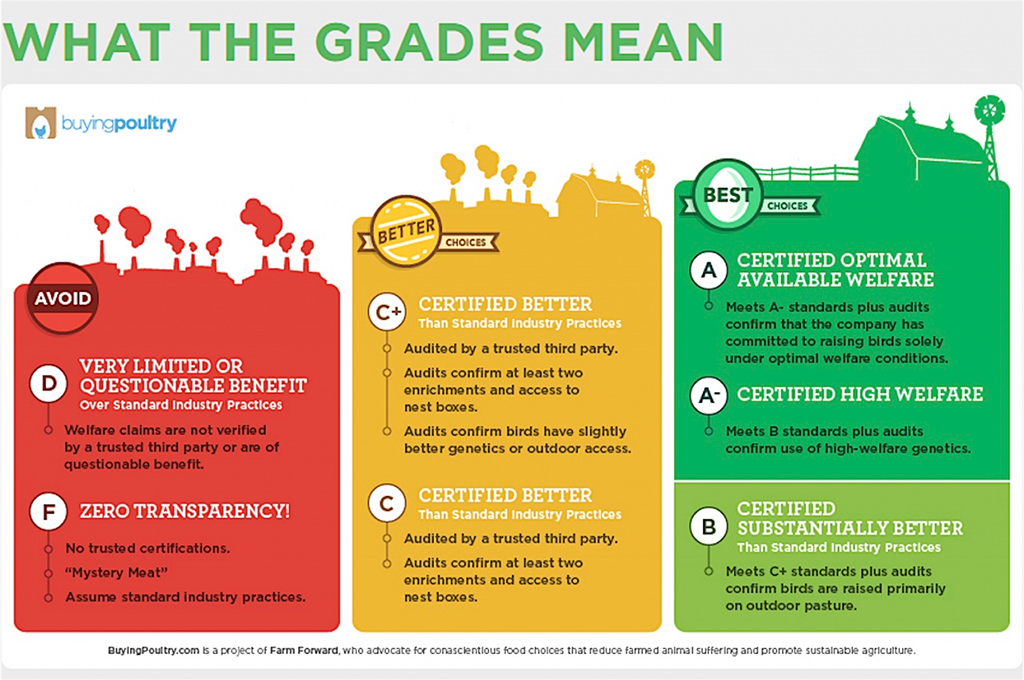
Organic, heritage, free-range... what the heck do all of these labels mean? Here's a quick guide for buying poultry.
I eased my shopping cart along the meat counter in a national chain grocery store to buy a whole chicken. Roast poultry for dinner seemed like a simple enough proposition. But like so many of us making food-purchasing decisions these days, I was stopped in my tracks by the range of choices.
Should I buy free-range or pasture-raised? Is organic better? Or is the best choice a brand like Foster Farms' Simply Raised (whatever that means, exactly)?
Confused by all of the labels and marketing claims, I gave up. My family ate a meatless stir-fry for dinner that night.
Later, I learned about a new online resource called Buyingpoultry.com designed to help consumers navigate the supermarket. Could the site guide conscious consumers like me to more sustainable chicken?
Chicken Production in a Nutshell, er... Eggshell
Anyone hoping to buy a chicken that is truly free-ranged on pastoral farmlands at a grocery store is generally out of luck.
The fact is that 99 percent of all chickens raised for meat (called broilers) in the U.S. come from factory farms. Through consolidation and high-tech breeding practices, the poultry industry has made chicken the most efficient and cheapest animal protein available.
Since 2010, broiler production has increased by more than 10 percent, according to statistics from the USDA. This graph looks surprisingly like the steep climb section on a Stairmaster program. Chicken production, which reached almost 9 billion birds in 2015, is still on the rise. Meanwhile, nationwide demand for barbecued-chicken pizza, chicken Caesar salad and General Tso's chicken keeps in step.
Trouble is, while making chicken America's favorite meat, the industrialized production system has incurred an untold debt to human health, the environment and the conditions of its own workers, not to forget the chickens themselves.
Consumers Demand Healthier Chicken
Amid a stream of salmonella-superbug outbreaks and public-health concerns over the routine use of human antibiotics, the USDA announced its plan for stricter regulations and testing in 2015. Two of the largest chicken producers, Tyson and Purdue, pledged to stop using human antibiotics to prevent disease in hatcheries and as growth promoters during maturation. Major food corporations, including McDonald's, Walmart and Subway, then vowed to shift toward purchasing chicken produced without human antibiotics.
Still, such improvements in the poultry market do not guarantee better animal welfare. According to whistleblower reports about the chicken industry and data from the ASPCA, cage-free chickens are still crammed into windowless barns for their short, dung-filled lives. These Cornish Cross birds, the main hybrid strain for the industry, grow three times as big in two-thirds the time as heritage breeds. Such fast fattening causes bone disorders, cardiovascular issues and other health issues over their roughly 45 days of life.
A Sustainable Buying Guide
After returning from my shopping fail, I Googled Buyingpoultry.com. Created by the Portland, Oregon-based nonprofit Farm Forward, it is the country's largest online database of poultry brands, products and retailers (including eggs and turkeys).
In the search field I typed in "Open Nature" and then "Foster Farms," two of the brands I'd considered. "Avoid," read the bold red graphic on my screen, and below that, "Birds likely suffer from the lowest levels of animal welfare." The fine print detailed how both brands received an F grade because they did not have any regulated animal-welfare claims or third-party certifications.
"Buyingpoultry.com lets you go to the store with experts," said Andrew deCoriolis, the website's architect, when I reached him by phone.
Helpfully, the search results page offered links to the highest-welfare poultry products available, as well as to a glossary of labels that clearly illustrates just how obfuscating and, in some cases, downright misleading the claims "free-range," "pasture-raised" and "humanely raised" actually are.
"Like Seafood Watch, Buyingpoultry.com can be a standard of sustainability and create more transparency," deCoriolis said.

Buying Better Poultry
One of the most upsetting experiences for the site's 5,000 to 10,000 monthly users, according to deCoriolis, is discovering how USDA-certified organic products rank. Browsing Buyingpoultry.com, they’re shocked to see organic products with a D grade. DeCoriolis explained, "Organic is better but not necessarily for the animals." For one thing, the USDA’s definition of "outdoor access" is ill-defined and does not stipulate indoor enrichments, including perches, or space for natural behaviors such as dust bathing.
At a different grocery store on another day, I opened Buyingpoultry.com on my phone's browser to check on a regional brand, Draper Valley, for sale. All products in this brand rated "Better Choices," and the organic line earned a C+. Since this was the best I could get in my area without visiting a small-scale farm, I nabbed this passing-grade chicken for our supper.
So what does it take to rate as a "Best Choices" chicken? According to Buyingpoultry.com's criteria, these are heritage-breed chickens raised by producers abiding by the highest standards of animal welfare, with their claims certified by third-party groups such as Animal Welfare Approved.
There's only a limited supply from retailers in certain markets, including Natural Grocers in Denver, Bi-Rite Market in San Francisco and some Whole Foods stores, but none at all at Trader Joe's or other national chains.
Persistent consumer advocacy is putting pressure on the poultry industry, however. "The big companies are paying attention," said deCoriolis. In March 2016, Whole Foods committed to stop selling fast-growing breeds by 2024. Starbucks and Nestlé soon followed, joining the animal-welfare initiative toward slower-growing chicken breeds raised in conditions where they can behave and interact like, well, actual all-natural chickens.
Copyright 2016 Lynne Curry via Zester Daily and Reuters Media Express